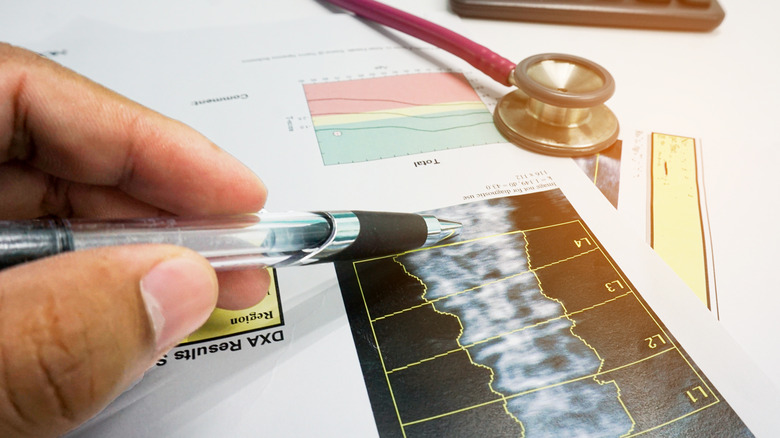Gaten Matarazzo's Rare Disease Explained
Over the years, 20-year-old Gaten Matarazzo, star of Netflix's hit supernatural horror series, "Stranger Things," has publicly shared his experience with a rare disease known as cleidocranial dysplasia or CCD (via Healthline). Derived from the word, "cleido," meaning collarbones, cleidocranial dysplasia is a rare condition characterized by collarbone, skull, and dental abnormalities, explains Johns Hopkins Medicine. It can also impact the legs and spine.
In 2020, Matarazzo posted a picture of himself on Instagram after having successfully undergone his fourth surgery for the condition. The actor had 14 teeth removed, explaining in the caption that those with cleidocranial dysplasia often develop extra teeth below the gums, which can obstruct the growth of one's adult teeth. For more information, Matarazzo directed fans to the CCD Smiles website, a non-profit organization established in 2017 that the star has partnered with. Cited in a 2021 interview via Future of Personal Health, Matarazzo stated, "My family helped me embrace my condition and feel confident. It never felt like an obstacle in my day-to-day life thanks to the people around me. I just want that to be the case for every kid growing up with CCD."
Signs and treatment of cleidocranial dysplasia
As a genetic condition, cleidocranial dysplasia is the result of an abnormality in the RUNX2 gene, which aids in bone and cartilage development, explains Johns Hopkins Medicine. Those with the condition may have wide-set eyes, a high-arched hard palate or cleft palate, a small midface, protruding forehead, thin tooth enamel, crowded teeth, and more. Other potential indicators of the condition include shorter fingers, extra or missing ribs, and scoliosis, amongst other symptoms. Some people may also be born with missing collarbones, as was the case with Gaten Matarazzo, reports NBC News.
Most treatment options for cleidocranial dysplasia involve various medical procedures or surgeries, according to Johns Hopkins Medicine. Facial reconstructive surgery may be utilized on the forehead or cheekbones for young kids. Alternatively, some people may require small portions of one's collarbone to be surgically removed in the event that it's causing the patient nerve issues or physical discomfort. Like Gaten Matarazzo, others may be in need of dental surgery to correct or remove excess or impacted teeth.
CCD can have many symptoms
Although CCD is a genetic condition, it is not among those that the Centers for Disease Control and Prevention (CDC) states can be detected before a woman gives birth. Instead, as the National Institute of Health explains, CCD is a condition discovered sometime between birth and four weeks of age. An official diagnosis may require x-rays or other tests, but these often come after medical personnel and family notice other physical traits like those mentioned above.
That's not to say that all of CCD's characteristics are limited to the face, however. The National Institute of Health goes on to say that CCD can also cause hearing loss, skeletal dysplasia throughout the body, and brachydactyly (a shortening of the fingers and toes) — as well as a shortened stature.
The condition can also cause osteoporosis and sleep apnea, conditions that can affect a range of people far beyond the estimated 5,000 Americans who live with CCD. Osteoporosis, according to Mayo Clinic, can also contribute to a shorter stature, as well as a stooped posture in addition to the brittle bones associated with the condition.
Sleep apnea, on the other hand, has an entirely unique set of symptoms that can compound with those caused by CCD. WebMD lists several of these symptoms, including morning headaches, nightmares, insomnia, and even dizziness upon waking.
The condition has a fairly long history
CCD only affects about 5,000 total Americans, according to the National Institute of Health. Despite this small number of patients, however, the condition has a rather long history. CCD Smiles states that 1765 marked the first recorded case of the condition — though it was not given a name until 1898. Then, for the next several decades, relevant discoveries seem more or less limited to identifying family clusters of people with CCD.
The responsible genetic chromosome was identified in 1995 during a boom in overall genetic research (via CDC Smiles). Researchers would make their next notable breakthrough only six years later, with the identification of multiple traits that had not previously been associated with CCD. Similar developments such as these would continue to mark the new millennium up to 2010.
At that point, the next largest development for CCD would be its turn in the limelight as Gaten Matarazzo hit screens around the world with the premiere of "Stranger Things." Milly Shapiro, another rising star, acted as another spotlight on CCD, with her own starring roles in films like "Hereditary. She and Gaten Matarazzo even attended a CCD Smiles event together in 2019 — an event Milly documented on her Instagram.




